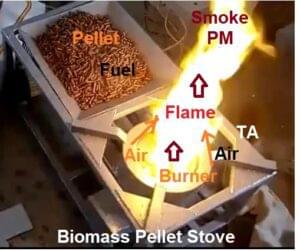Heating Input or Gas Firing Rate for Gas Burners
- The heat input () to a system can be calculated using the fuel flow rate () and the heating value (L) of the fuel.
- The heating value represents the amount of energy released per unit mass or volume of the fuel. The formula for calculating heat input is:
where:
- is the heat input (measured in energy units such as Joules or British Thermal Units, BTUs),
- is the mass flow rate of gas fuel (measured in mass or volume per unit time, e.g., kg/s or L/min),
- L is the Lower heating value of the fuel (measured in energy per unit mass or volume, e.g., J/kg or BTU/L).
- Make sure that the units for fuel flow rate and heating value are compatible, and if necessary, convert them to a consistent set of units before plugging them into the formula.
- For example, let’s say you have a fuel flow rate of 5 kg/s and a heating value of 45,000 J/kg.
- The heat input () would be:
Q=5 kg/s×45,000 J/kg=225,000 J/s
- You can further convert the result to kilowatts (kW) by dividing by 1,000 (since 1 kW = 1,000 J/s):
Q=225,000 J/s1*,000=225 kW
- So, the heat input to the system would be 225 kW in this example.
Calculation of Air Required for Burning of LPG Fuel
- Insert Firing rate in MW or Million Btu/hr
- Insert the values of fuel composition: C2H6: 50%, C3H8: 50%
- Get values of the amount of gas and air consumption
- For more information visit the website of CFD Flow Engineering

Firing rate of Biomass Pellet Calculations
- The firing rate of biomass pellets refers to the rate at which biomass is consumed during combustion, typically expressed in terms of mass per unit time (e.g., kg/hr or tons/hr).
- To calculate the firing rate of biomass pellets, several factors are considered, such as the energy demand (heat output), efficiency of the combustion system, and the calorific value of the biomass.
Here’s a step-by-step approach to calculating the firing rate:
1. Determine the Energy Demand (Heat Output)
- The energy demand is the amount of heat required for the process (e.g., heating, power generation, industrial furnaces). It is typically expressed in kilowatts (kW) or megawatts (MW), or in BTUs per hour for non-metric units.
- For example, if the system requires 1000 kW (1 MW) of thermal energy output, this will be the baseline for your calculations.
2. Calorific Value of Biomass Pellets
- The calorific value (or heating value) of biomass pellets is the amount of energy released when a given mass of biomass is burned.
- It is usually measured in megajoules per kilogram (MJ/kg) or BTU/lb.
- For biomass pellets, the calorific value typically ranges between 15–19 MJ/kg.
- Let’s assume the calorific value of your biomass pellet is 18 MJ/kg.
3. Combustion System Efficiency
- The efficiency of the combustion system is the percentage of the energy in the fuel that is converted to usable heat.
- It is often expressed as a decimal (e.g., 85% efficiency = 0.85).
- Biomass boilers or furnaces typically have efficiencies ranging from 70% to 90%.
- Assume the efficiency of the combustion system is 85%.
4. Formula for Firing Rate Calculation
- The firing rate can be calculated using the following formula:
Firing Rate=Energy Demand/( Calorific Value × System Efficiency)
Where:
-
- Energy Demand is the heat output required by the system (in MJ/hr or kW).
- Calorific Value is the energy released per kilogram of biomass (in MJ/kg).
- System Efficiency is the efficiency of the combustion system (as a decimal).
5. Convert Energy Demand to Appropriate Units
- If the energy demand is provided in kW, it must be converted to MJ/hr, since 1 kW = 3.6 MJ/hr.
- For example, a 1000 kW system would require 3600 MJ/hr (1000 × 3.6).
6. Example Calculation
- Let’s calculate the firing rate for a system requiring 1000 kW of thermal energy, with a calorific value of 18 MJ/kg for the biomass pellets, and a system efficiency of 85%.
Firing Rate=3600 MJ/hr18 MJ/kg×0.85
- So, the system would need approximately 235.29 kg/hr of biomass pellets to meet the energy demand of 1000 kW.
7. Adjusting for Other Variables
- Moisture content of the biomass pellets can impact the calorific value. If the pellets are wet, their effective calorific value decreases, requiring a higher firing rate.
- Air-fuel ratio: Adequate air supply is crucial for complete combustion.
- Too little air results in incomplete combustion, while too much air reduces efficiency by carrying away excess heat.
Summary:
- To calculate the firing rate of biomass pellets:
- Determine the energy demand of the system in MJ/hr or kW.
- Find the calorific value of the biomass pellets in MJ/kg.
- Adjust for the efficiency of the combustion system.
- Apply the formula to calculate the required firing rate in kg/hr.
- This method ensures that the firing rate is sufficient to meet the energy demand while accounting for fuel quality and system efficiency.